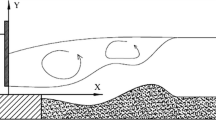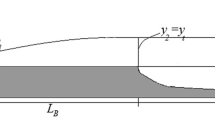Abstract
For the abutment bed scour to reach its equilibrium state, a long flow time is needed. Hence, the employment of usual strategy of simulating such scouring event using the 3D numerical model is very time consuming and less practical. In order to develop an applicable model to consider temporally long abutment scouring process, this study modifies the common approach of 2D shallow water equations (SWEs) model to account for the sediment transport and turbulence, and provides a realistic approach to simulate the long scouring process to reach the full scour equilibrium. Due to the high demand of the 2D SWEs numerical scheme performance to simulate the abutment bed scouring, a recently proposed surface gradient upwind method (SGUM) was also used to improve the simulation of the numerical source terms. The abutment scour experiments of this study were conducted using the facility of Hydraulics Laboratory at Nanyang Technological University, Singapore to compare with the presented 2D SGUM–SWEs model. Fifteen experiments were conducted with their scouring flow durations vary from 46 to 546 h. The comparison shows that the 2D SGUM–SWEs model gives good representation to the experimental results with the practical advantage.






Similar content being viewed by others
Abbreviations
- c :
-
Wave celerity
- C :
-
Flux averaged volumetric sediment concentration
- \(C_{\mathrm{E}}\) :
-
Equilibrium sediment concentration
- \(C_{\mathrm{FL}}\) :
-
Courant number
- \(d_d\) :
-
Sediment median diameter
- \(d_\mathrm{f}\) :
-
Flow depth in floodplain
- \(d_\mathrm{m}\) :
-
Flow depth in main channel
- \(d_\mathrm{s}\) :
-
Scour depth
- \(d_\mathrm{sc}\) :
-
Sediment deposition rate
- \(d_\mathrm{se}\) :
-
Equilibrium scouring depth
- \(e_\mathrm{sc}\) :
-
Sediment erosion rate
- g :
-
Gravitational acceleration
- h :
-
Water depth
- i :
-
Space step
- k :
-
Flow energy
- L :
-
Abutment length
- \(l_\mathrm{A}\) :
-
Dimensionless adaptation length scale
- m :
-
Last time space
- n :
-
Manning’s friction coefficient
- N :
-
Time step
- Q :
-
Resultant velocity
- \(Q_\mathrm{fm}\) :
-
Discharge from magnetic flow metre
- \(Q_\mathrm{vel}\) :
-
Discharge obtained from integration of ADV point-measured velocities
- s :
-
wave speed
- \(S_\mathrm{f}\) :
-
Friction/energy slope of flow
- \(S_\mathrm{o}\) :
-
Bed slope
- \(s_\mathrm{s}\) :
-
Sediment specific density
- t :
-
Time domain
- \(t_\mathrm{actual}\) :
-
Actual scouring time run for an experiment
- \(t_\mathrm{e}\) :
-
Equilibrium scouring time
- u :
-
Depth averaged flow velocity in streamwise direction
- \(U_\mathrm{f}\) :
-
Flow velocity at flood plain
- \(U_{\mathrm{m}}\) :
-
Flow velocity at main channel
- \(u_\mathrm{s}\) :
-
Shear velocity
- v :
-
Depth averaged flow velocity in lateral direction
- \(w_\mathrm{V}\) :
-
Sediment fall velocity
- x :
-
Spatial-longitudinal domain
- y :
-
Spatial-transverse domain
- \(z_\mathrm{b}\) :
-
Mobile bed elevation
- \(\nabla \) :
-
Gradient operator
- \(\varepsilon \) :
-
Flow energy dissipation
- \(\lambda \) :
-
Sediment bed porosity
- \(\nu _\mathrm{t}\) :
-
Depth averaged turbulent viscosity
- \(\varOmega \) :
-
Computational cell area
- \(\phi \) :
-
Flow geopotential
- \(\Pi \) :
-
Slope limiter
- \(\rho _\mathrm{s}\) :
-
Density of sediment
- \(\rho _\mathrm{w}\) :
-
Density of water
- \(\sigma _\mathrm{g}\) :
-
Geometric standard deviation of sediment size
- L:
-
Left region
- R:
-
Right region
- *:
-
Star region
- ADV:
-
Acoustic Doppler velocimeter
- FV:
-
Finite volume
- HLLC:
-
Harten Lax van Leer-contact
- MUSCL:
-
Monotonic upwind scheme for conservative laws
- NS:
-
Navier Stokes
- SCC:
-
Sediment transport continuity-concentration
- SGUM:
-
Surface gradient upwind method
- SWEs:
-
Shallow water equations
References
Yin J, Chen Y, Falconer RA (2003) Steady shallow-water current and solute transport around a semi-conical headland. Environ Fluid Mech 3(3):221–234
Souhar O, Faure J-B, Paquier A (2007) Automatic sensitivity analysis of a finite volume model for two-dimensional shallow water flows. Environ Fluid Mech 7(4):303–315
Ettema R, Yoon B, Nakato T, Muste M (2004) A review of scour conditions and scour-estimation difficulties for bridge abutments. KSCE J Civil Eng 8(6):643–650
Dey S, Barbhuiya AK (2005) Time variation of scour at abutments. J Hydraul Eng 131(1):11–23
Yanmaz AM, Kose O (2007) Time-wise variation of scouring at bridge abutments. Sadhana 32(3):199–213
Ballio F, Radice A, Dey S (2010) Temporal scales for live-bed scour at abutments. J Hydraul Eng 136(7):395–402
Lim SY (1997) Equilibrium clear-water scour around an abutment. J Hydraul Eng 123(3):237–243
Lu J-Y, Shi Z-Z, Hong J-H, Lee J-J, Raikar RV (2011) Temporal variation of scour depth at nonuniform cylindrical piers. J Hydraul Eng 137(1):45–56
Nugroho J (2006) Flow distribution and scouring around abutments in two-stage channels. Ph.D Dissertation, Nanyang Technological University, Singapore
Pu JH (2008) Efficient finite volume numerical modelling and experimental study of 2D shallow water free surface turbulent flows. Ph.D Dissertation, University of Bradford, Bradford, UK
Liu X, Garcia MH (2008) Three-dimensional numerical model with free water surface and mesh deformation for local sediment scour. J Hydraul Eng 134(4):203–217
Bihs H, Olsen NRB (2011) Numerical modeling of abutment scour with the focus on the incipient motion on sloping beds. J Hydraul Eng 137(10):1287–1292
Sladkevich M, Militeev AN, Rubin H, Kit E (2000) Simulation of transport phenomena in shallow aquatic environment. J Hydraul Eng 126(2):123–136
Kimura I, Uijttewaal WSJ, Hosoda T, Ali MS (2009) URANS computations of shallow grid turbulence. J Hydraul Eng 135(2):118–131
Mahdizadeh H, Stansby PK, Rogers BD (2012) Flood wave modeling based on a two-dimensional modified wave propagation algorithm coupled to a full-pipe network solver. J Hydraul Eng 138(3):247–259
Cao Z, Pender G, Wallis S, Carling P (2004) Computational dam-break hydraulics over erodible sediment bed. J Hydraul Eng 130(7):689–703
Wu W, Wang SSY (2007) One-dimensional modeling of dam-break flow over movable beds. J Hydraul Eng 133(1):48–58
Wu W, Wang SSY (2008) One-dimensional explicit finite-volume model for sediment transport with transient flows over movable beds. J Hydraul Res 46(1):87–98
Xia J, Lin B, Falconer RA, Wang G (2010) Modeling dam-break flows over mobile beds using a 2D coupled approach. Adv Water Resour 33(2):171–183
Cao Z, Hu P, Pender G (2011) Multiple time scales of fluvial processes with bed load sediment and implications for mathematical modeling. J Hydraul Eng 137(3):267–276
Younus M, Chaudhry MH (1994) A depth-averaged \(\text{ k- }{\varepsilon }\) turbulence model for the computation of free-surface flow. J Hydraul Res 32(1):415–444
Cea L, Puertas J, Vazquez-Cendon ME (2007) Depth average modelling of turbulent shallow water flow with wet-dry fronts. Arch Comput Method Eng 14(3):303–341
Pu JH, Cheng N-S, Tan SK, Shao S (2012) Source terms treatment of SWEs using surface gradient upwind method. J Hydraul Res 50(2):145–153
Ferreira R, Leal J (1998) 1D mathematical modelling of the instantaneous dam-break flood wave over mobile bed: application of TVD and flux-splitting schemes. In: Proceedings of European concerted action on dam-break modelling, Munich, Germany, pp 175–222
Yang CT, Greimann BP (1999) Dambreak unsteady flow and sediment transport. In: Proceedings of European concerted action on dam-break modelling, Zaragoza, Spain, pp 327–365
Brufau P, Garcia-Navarro P, Ghilardi P, Natale L, Savi F (2000) 1D mathematical modelling of debris flow. J Hydraul Res 38(6):435–446
Zhou J, Lin B (1998) One-dimensional mathematical model for suspended sediment by lateral integration. J Hydraul Eng 124(7):712–717
Valiani A, Caleffi V (2001) Dam break modeling for sediment laden flows. In: Proceedings of the 2001 international symposium on environmental hydraulics. Arizona, USA, pp 1–6
Armanini A, Di Silvio G (1988) A one-dimensional model for the transport of sediment mixture in non-equilibrium conditions. J Hydraul Res 26(3):275–292
Pu JH, Shao S, Huang Y (2013) Turbulence studies of shallow open channel flows using numerical and experimental approaches. J Hydro-environ Res 1–11. doi:http://dx.doi.org/10.1016/j.jher.2012.12.001
Toro EF (1999) Riemann solvers and numerical methods for fluid dynamics: a practical introduction, 2nd edn. Springer, Berlin
Hu K, Mingham CG, Causon DM (2006) A mesh patching method for finite volume modelling of shallow water flow. Int J Num Meth Fluids 50(11):1381–1404
Mingham CG, Causon DM (2000) Calculation of unsteady bore diffraction using a high resolution finite volume method. J Hydraul Res 38(1):49–56
Sanders BF, Green CL, Chu AK, Grant SB (2001) Case study: modeling tidal transport of urban runoff in channels using the finite-volume method. J Hydraul Eng 127(10):795–804
Lim SY, Nugroho J (2004) Observations on flow field around an abutment in a two-stage channel. In: Proceedings of 2nd international conference on scour and erosion, Singapore, pp 156–164
Melville BW, Chiew YM (1999) Time scale for local scour at bridge piers. J Hydraul Eng 125(1):59–65
Coleman SE, Lauchlan CS, Melville BW (2003) Clear water scour development at bridge abutments. J Hydraul Res 41(5):521–531
Acknowledgments
The authors would like to thank Dr. Joko Nugroho for providing his Ph.D. experimental data (under the supervision of the second author Dr. Siow Yong Lim).
Author information
Authors and Affiliations
Corresponding author
Rights and permissions
About this article
Cite this article
Pu, J.H., Lim, S.Y. Efficient numerical computation and experimental study of temporally long equilibrium scour development around abutment. Environ Fluid Mech 14, 69–86 (2014). https://doi.org/10.1007/s10652-013-9286-3
Received:
Accepted:
Published:
Issue Date:
DOI: https://doi.org/10.1007/s10652-013-9286-3




